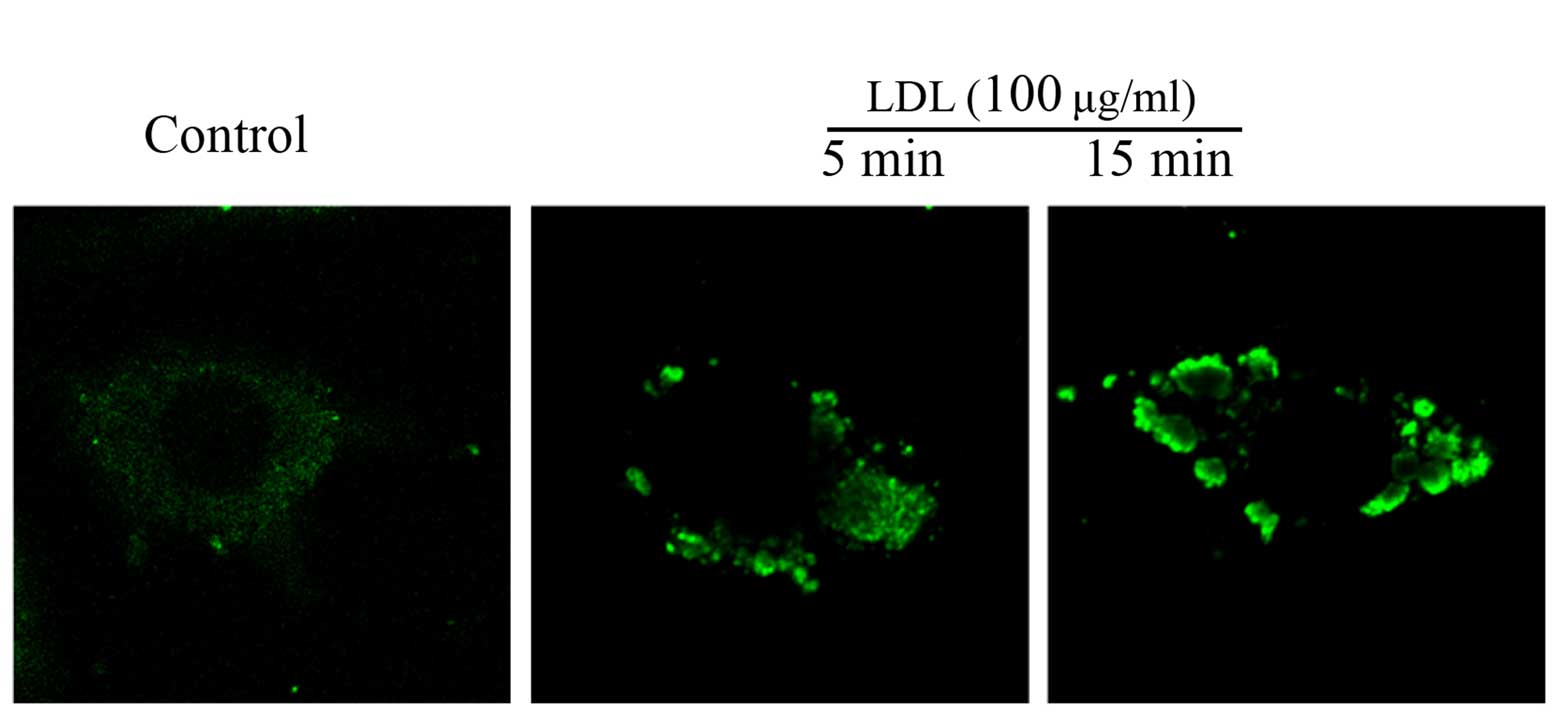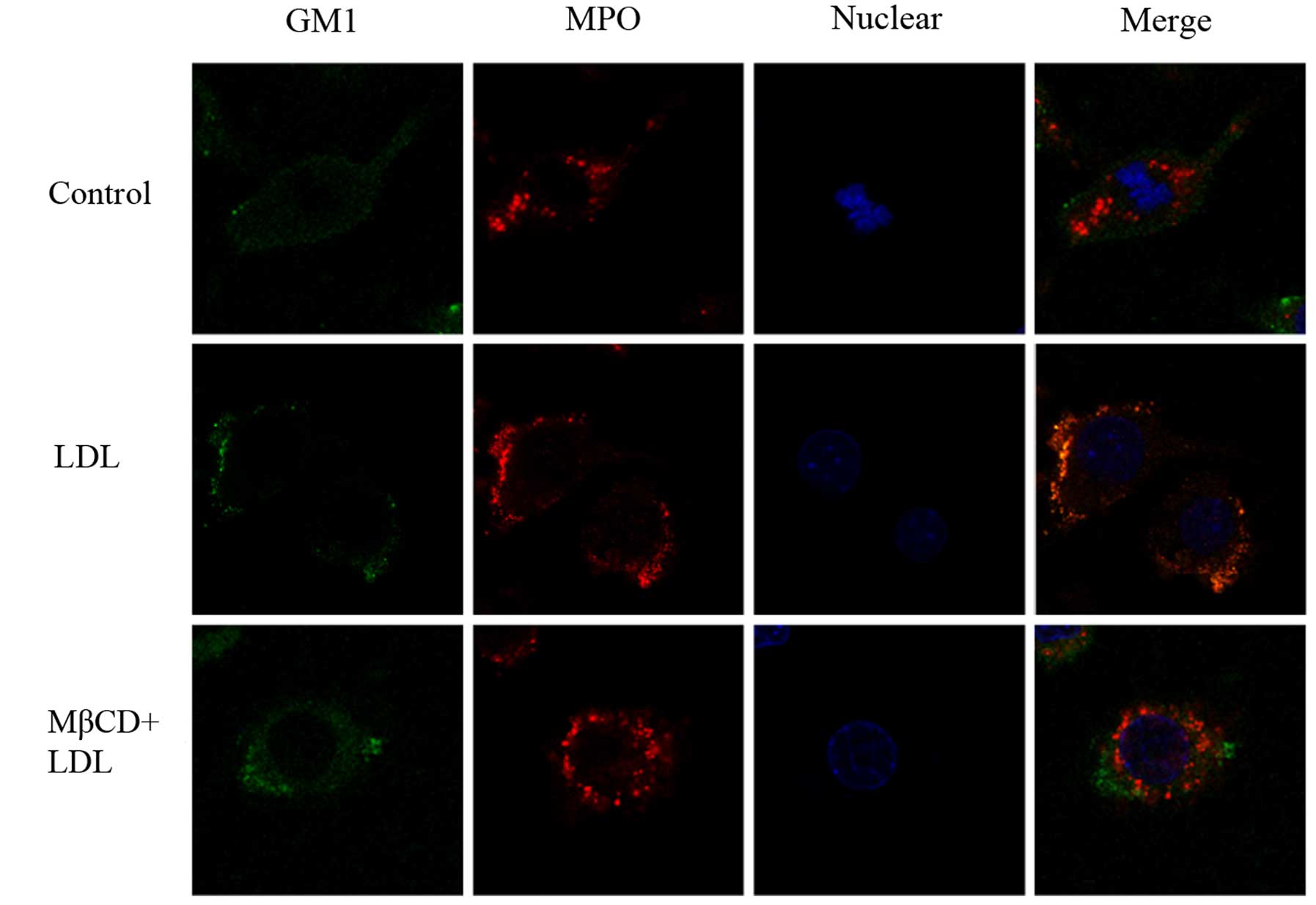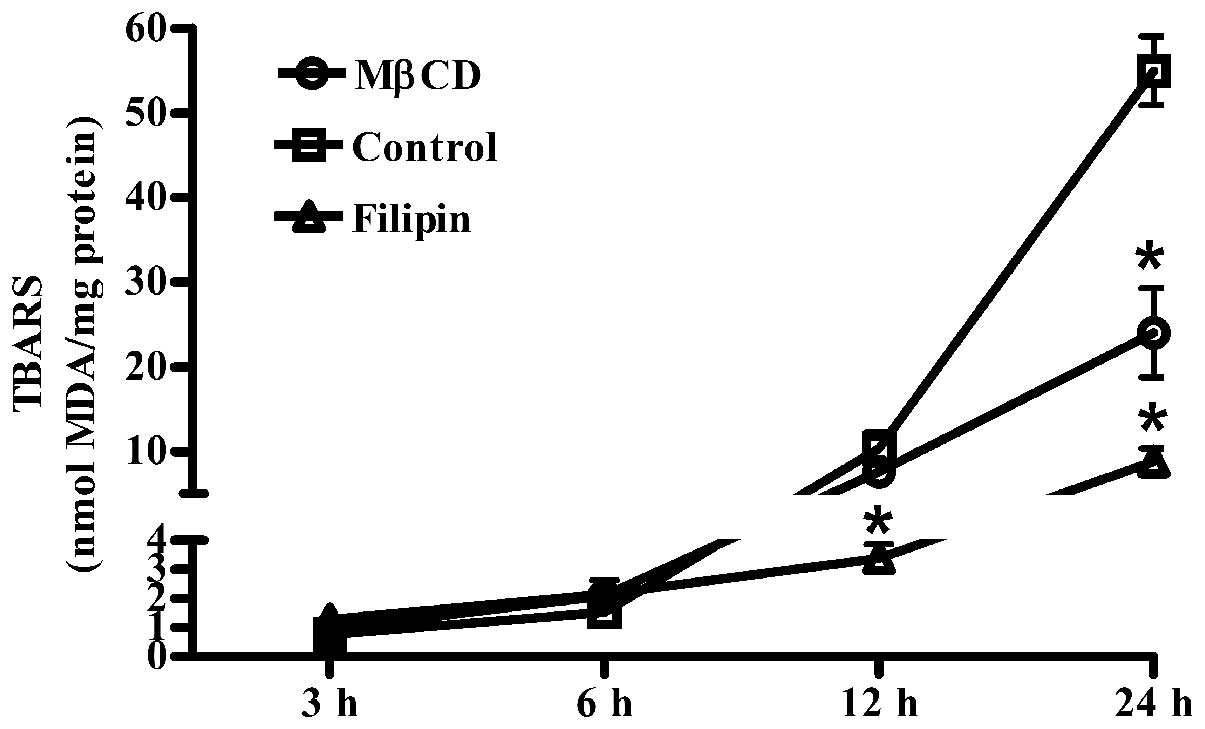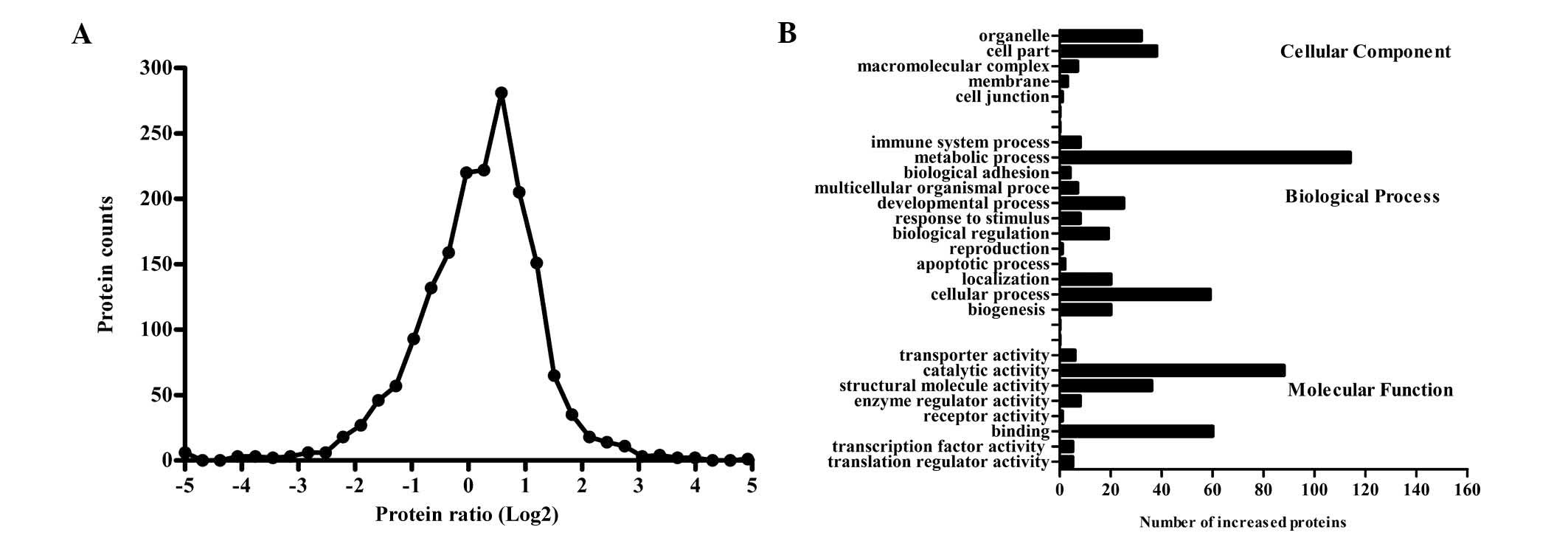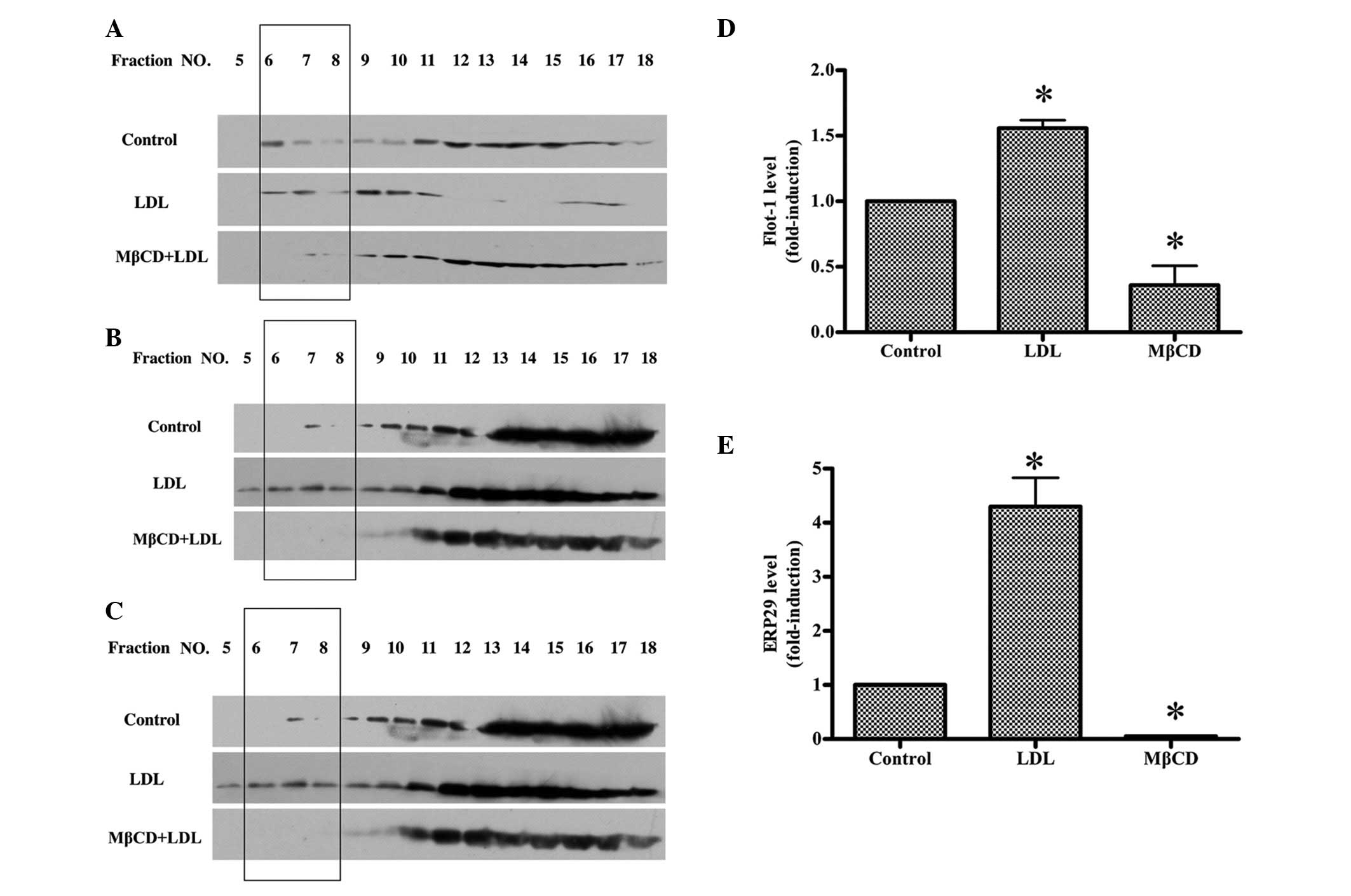Native low density lipoprotein promotes lipid raft formation in macrophages
- Authors:
- Published online on: January 14, 2016 https://doi.org/10.3892/mmr.2016.4781
- Pages: 2087-2093
-
Copyright: © Song et al. This is an open access article distributed under the terms of Creative Commons Attribution License.
Abstract
Introduction
Atherosclerosis (AS) is a pathological process associated with the majority of cardiocerebrovascular diseases, and is a predominant cause of morbidity and mortality worldwide (1). Oxidized low-density lipoproteins (ox-LDLs) are known to be of importance in the pathogenesis of AS. However, the precise mechanism underlying LDL oxidation has yet to be fully elucidated (2).
All three major cell types of the human atherosclerotic lesions, particularly macrophages are hypothesized to be the principal mediators of LDL oxidation (3,4). Macrophages have been shown to modulate LDL oxidation through the production of reactive oxygen species (5), lipoxygenase (6), and myeloperoxidase (MPO) (7). MPO is a highly cationic protein that is able to bind to endothelial cells, leukocytes and LDL (2). Sokolov et al (8) concluded that the likely site of interaction with MPO is the amino acid stretch 445–456 of apoB-100 though mimicking 3 kinds of apoB-100 fragments. Numerous studies have suggested that MPO adsorbs onto the surface of LDL, promoting the oxidation of amino acid residues and the formation of oxidized lipoproteins (9,10).
In vitro, various antioxidants are able to inhibit LDL oxidation, such as vitamin E and probucol. In vivo, serum or interstitial fluid is able to markedly inhibit LDL oxidation by cells due to the presence of vitamin C in human plasma, interstitial fluid and arterial walls (11). As early as 1990, Heiple et al (12) hypothesized that macrophages were able to create a closed compartment on the plasma membrane and substrate that excludes proteins in the surrounding medium, thereby protecting cells from external factors. This may explain the ineffectiveness of antioxidants in clinical therapy as compared with in vitro studies.
Lipid rafts are membrane microdomains characterized by a high content of sphingolipids and cholesterol, and a low content of protein (13). Lipid rafts have been shown to participate in numerous important steps of atherogenesis, such as inflammation (14), apo-A1-mediated cholesterol efflux (15) and the secretion of pro-inflammatory cytokines by immune cells (16). Lipid rafts in macrophages are important for vesicular trafficking, transmembrane signal transduction, protein translocation and cytoskeletal rearrangements (17). In response to various stimuli, numerous molecules move into or out of the lipid rafts. These molecules include, but are not limited to, toll-like receptor 4 (18) and class A scavenger receptor (19), which affect macrophage functions. However, the mechanism underlying the effect of LDL on the translocation and identity of their target molecules in lipid rafts remains unknown.
The present study demonstrated that native-LDL promotes lipid raft clustering in macrophages, and identified lipid raft-associated proteins by label-free quantitative proteomic analysis, in order to gain further insight into LDL oxidation.
Materials and methods
Materials
Methyl-β-cyclodextr in (MβCD) and anti-neutrophil myeloperoxidase [MPO; mouse anti-goat polyclonal IgG (H+L)] antibodies were obtained from Santa Cruz Biotechnology, Inc. (1:100, cat. no. sc-16129, Dallas, TX, USA), along with lipid-raft disruptor filipin. Alexa Fluor 488-cholera toxin subunit B (CTXB) and Alexa Fluor 594-labeled chicken anti-Goat IgG (H+L) secondary antibody were purchased from Invitrogen (Thermo Fisher Scientific, Inc., Waltham, MA, USA). Anti-flotillin-1 antibody was purchased from BD Biosciences (1:1000, cat no. 61802; Franklin Lakes, NJ, USA). Polyclonal anti-ERp29 rabbit anti-mouse antibody was obtained from Abcam (1:3000, ab11420; Cambridge, MA, USA). Optiprep was obtained from Axis-Shield, Inc. (Norton, MA, USA). High glucose Dulbecco's modified Eagle's medium (DMEM) was purchased from GE Healthcare Life Sciences (Logan, UT, USA). An Enhanced Chemiluminescence (ECL) kit was obtained from PerkinElmer Inc. (Waltham, MA, USA). Human LDL was purchased from ProSpec-Tany TechnoGene, Ltd. (Ness Ziona, Israel).
Cell culture and oxidation of native LDL in Raw264.7 cells
Raw264.7 mouse macrophages were purchased from the China Centre for Type Culture Collection (Wuhan, China). The cells were cultured in high glucose DMEM supplemented with 10% fetal bovine serum (Thermo Fisher Scientific, Inc.), 100 U/ml penicillin and 100 mg/ml streptomycin (both from Thermo Fisher Scientific, Inc.) at 37°C and in 5% CO2. When cell density reached 70–80% confluence, the cells were washed three times with phosphate-buffered saline and pre-incubated for 2 h in serum-free DMEM for LDL oxidation. The Raw264.7 cell line was incubated with native-LDL (100 µg/ml) at 37°C for 3, 6, 12 and 24 h.
Cholesterol depletion
To disrupt lipid raft membrane domains, membrane cholesterol was depleted by treating the Raw264.7 cells with DMEM supplemented with 5 mM MβCD for 30 min or 100 nM filipin for 15 min at 37°C.
Thiobarbituric acid assay (TBA)
The TBA assay was used to assess the extent of cell-mediated LDL oxidation as described previously (20). TBA reacts with malondialdehyde (MDA) and MDA-like derivatives to form TBA reactive species, which may be quantified by spectrophotometry at 535 nm using a UV-2000 spectophotometer [UNICO (Shanghai) Scientific Instrument Co., Ltd.]. Data are presented as MDA equivalents (nM MDA/mg protein).
Confocal analysis of lipid rafts and their colocalization with LDL and MPO in Raw264.7 cells
Detection of lipid rafts was performed as described previously (21). Briefly, the Raw264.7 cells were fixed with 4% paraformaldehyde (Sigma-Aldrich) and double stained with Alexa Fluor 488-CTXB (which attaches to ganglioside GM1 and thus does not require a second antibody), or incubated with anti-MPO antibody followed by Alexa Fluor-594-labeled secondary antibody, prior to being visualized under a DM6000 confocal microscope (Leica Microsystems GmbH, Wetzlar, Germany).
Isolation of detergent-free lipid rafts
Detergent-free rafts were prepared using the OptiPrep gradient method previously described by Macdonald and Pike (22). Following centrifugation at 52,000 × g for 90 min, cloudiness was observed throughout the gradient. A diffuse band was observed about one-third of the way down the gradient, and a distinct band was apparent at the interface of the 20% end of the gradient and the 25% OptiPrep bottom layer. The gradients were fractionated into 0.67 ml fractions (each in a new tube), and the distribution of various proteins was assessed by western blotting as described below.
Western blotting
Total protein from each fraction was determined using a bicinchoninic acid assay kit (Thermo Fisher Scientific, Inc.). The proteins were separated by 12% sodium dodecyl sulfate-polyacrylamide gel electrophoresis prior to being electrophoretically transferred onto nitrocellulose membranes (GE Healthcare Life Sciences). The membranes were blocked using 5% non-fat milk in Tris-buffered saline with Tween 20 (TBST) for 1 h, incubated with primary antibodies against anti-flotillin-1, ERp29 and transferrin (1:2,000; cat. no. ab84036, Abcam) in TBST overnight at 4°C, followed by incubation with horseradish peroxidase-conjugated goat anti-rabbit/anti-mouse secondary antibodies [1:1,000; cat. nos. A0208, A0216; IgG (H+L); Beyotime Institute of Biotechnology, Haimen, China]. Prior to being washed three times with TBST. Protein bands were visualized on X-ray film (Kodak, Rochester, NY, USA) and quantified using Image J software (version 1.48U; National Institutes of Health, Bethesda, MA, USA).
Mass spectrometry analysis
In-gel digestion with trypsin was performed as previously described (23–25). Peptide samples were resuspended in loading buffer (containing 0.1% formic acid, 0.03% trifluoroacetic acid and 1% acetonitrile) and loaded onto a 15 cm nano-HPLC column (internal diameter 100 µm) packed with Reprosil-Pur 120 C18-AQ 1.9 µm beads (Dr Maisch HPLC GmbH, Ammerbuch, Germany), and eluted for 120 min with 4–80% buffer B reverse phase gradient (buffer A, 0.1% formic acid and 1% acetonitrile in water; buffer B, 0.1% formic acid in acetonitrile) generated by a NanoAcquity UPLC system (Waters Corporation, Milford, MA, USA). The peptides were ionized with 2.0 kV electrospray ionization voltage from a nano-ESI source (Thermo Fisher Scientific, Inc.) on a hybrid LTQ XL Orbitrap mass spectrometer (Thermo Fisher Scientific, Inc.).
Data-dependent acquisition of centroid MS spectra at 30,000 resolution and MS/MS spectra were obtained in the LTQ following collision-induced dissociation (collision energy, 35%; activation Q, 0.25; and activation time, 30 msec) for the top 10 precursor ions, with charge determined by the Sage Sorcerer SEQUEST (version 3.5; Sage-N Research, Inc., Milpitas, CA, USA) acquisition software to be z≥2. Dynamic exclusion of peaks already sequenced at 30 sec with early expiration for two count events with signal-to-noise >2. Automatic gating control was set to 150 msec maximum injection time. The Sage Sorcerer SEQUEST (version 3.5; Sage-N Research, Inc.) was used to search and match MS/MS spectra to a complete semi-tryptic mouse proteome database (NCBI reference sequence revision 54, with 34,421 target entries; http://www.ncbi.nlm.nih.gov/refseq/) and a pseudo-reversed decoys sequences (26,27) with a 20 ppm mass accuracy threshold. Static modifications for cysteine carbamidomethyl (+57.021465) and dynamic modifications for oxidized methionine (+15.99492) were included. Only b and y ions were considered for scoring (Xcorr), and Xcorr along with ΔCn were dynamically increased for groups of peptides organized by a combination of trypticity (fully or partial) and precursor ion charge state in order to remove false positive hits along with decoys until a false discovery rate (FDR) of <1% was achieved.
The FDR was estimated by the number of decoy matches (nd) and total number of assigned matches (nt): FDR=2nd/nt, assuming mismatches in the original database were the same as in the decoy database (28). Quantification of proteins was based on the comparison of extracted ion current intensities for identified peptides as previously described (29).
Protein-protein interaction analysis
The upregulated proteins were analyzed using the Panther classification system (http://www.pantherdb.org/) and were assigned to various functional groups.
Statistical analysis
All values are presented as the mean ± standard deviation. Statistical analyses were performed using GraphPad Prism software (version 5; GraphPad Software, Inc., La Jolla, CA, USA). The paired, two-tailed Student's t-test was used to analyze the significance of the difference between groups. P<0.05 was considered to indicate a statistically significant difference.
Results
Native-LDL promotes lipid raft clustering in macrophages
Previous studies have demonstrated that ox-LDL induced aggregation of gp91phox (30) and Fas (31) in lipid rafts. In order to examine whether native-LDL induces lipid raft clustering, GM1 ganglioside (the predominant lipid raft component) was stained using Alexa-488-labeled CTXB. As shown in Fig. 1, native-LDL stimulation caused an aggregation of GM1, exhibited as green dots or patches. These results suggest that treatment with native-LDL led to the formation of lipid rafts in Raw264.7 cells.
Native-LDL-induces aggregation of MPO in lipid raft clusters
To examine whether MPO was able to aggregate in lipid raft clusters following native-LDL stimulation, Raw264.7 cells were stained with Alexa-488 CTXB and Alexa-594-conjugated anti-MPO, and the distribution of MPO in lipid raft clusters was visualized by confocal microscopy. As shown in Fig. 2, MPO, an important enzyme involved in the oxidation of LDL, was distributed in both the membrane and cytosol of cells. After LDL treatment, MPO was redistributed in the plasma membrane and colocalized with GM1, so LDL increased MPO translocation into lipid rafts. This colocalization was blocked in MβCD-treated cells.
Lipid raft disruptors attenuate LDL oxidation in Raw264.7 cells
The role of lipid rafts in macrophage-mediated LDL oxidation was investigated. Fig. 3 shows that Raw264.7 cells oxidized human LDL over a 24 h time period, which was significantly decreased following treatment with MβCD and filipin compared with the controls.
Total protein concentration in lipid rafts was increased following treatment with LDL in Raw264.7 cells
Lipid rafts were isolated and purified from non-treated and LDL-stimulated Raw264.7 cells using OptiPrep gradient centrifugation. As shown in Fig. 4, low protein concentration levels were present in the lipid raft fractions (fraction 6–8). The highest protein concentration levels were located at the bottom of the gradient. However, an increase in total protein concentration levels was observed in fraction 7, and the total protein levels in the lipid rafts fractions significantly increased following treatment with LDL (P<0.05).
Quantitative proteomics of lipid raft-associated proteins induced by LDL in Raw264.7 cells
To identify differentially regulated lipid raft-associated proteins following LDL stimulation, label-free quantitative proteomics analysis was performed on lipid raft fractions of macrophages. The distribution of the ratios of protein abundance between the LDL-stimulated macrophages and the resting state is shown in Fig. 5A. The present study identified 1,449 proteins with ≥1 unique peptides with quantifiable abundance measurements, of which many were lipid raft marker proteins, including flotillins and glycosylphosphatidylinositol-anchored proteins. From the identified proteins, a fold change of ≥2 was used to define differential regulation. Out of the 1,449 proteins, 204 and 203 proteins were shown to be downregulated and upregulated following LDL stimulation, respectively. Protein groups were then sorted according to biological processes, cellular components and molecular function GO categories (Fig. 5B). Upregulated proteins comprised GO terms associated with metabolic processes and response to stimuli. Notably, the results also demonstrated enrichment for biological adhesion, localization, and enzyme regulator activity. Furthermore, apoB100 was identified in lipid rafts when the protein spectra were matched to a human proteome database, which indicated the human origin of LDL.
The 203 upregulated proteins were analyzed using STRING. Numerous interaction groups were apparent, such as Hmox-1 - Bax, Pfn - Cap-1. Notably, ERp29 was associated with calreticulin.
Validation of the label-free quantification of lipid raft proteins by immunoblotting
To further validate the proteomic identification results, the expression levels of one of the upregulated proteins, ERp29, were analyzed by western blotting. The floated low density fractions 6, 7 and 8 (lipid rafts observed one-third of the way down the gradient) represented the lipid raft fractions following gradient ultra-centrifugation of the cell lysates. As shown in Fig. 6A, the proteins from various fractions were immunoblotted for flotillin-1, a well-documented marker protein of lipid rafts using an anti-flotillin-1 antibody. It was demonstrated that flotillin-1 localized not only in lipid raft fractions, but also in non-raft fractions (high density fractions). It should be noted that this was not due to unsuccessful isolation of the lipid raft, but a phenomenon observed in previous studies (22,32). LDL induced a significant increase of the flotillin-1 into lipid raft, however, pre-treatment with MβCD almost entirely disrupted the lipid raft fractions, as determined by the lack of flotillin-1 in raft fractions. As shown in Fig. 6B, the expression levels of ERp29 in lipid rafts were significantly increased following treatment with LDL. This increase in expression levels was suppressed by MβCD pre-treatment. Notably, the transferrin receptor, a marker for the non-raft plasma membrane, was distributed at the bottom of the gradient (Fig. 6C), indicating that non-raft plasma membrane did not significantly contaminate the major lipid raft fractions. Bar graphs show the band density ratio of Flot-1 (Fig. 6D) and ERp29 (Fig. 6E), respectively.
Discussion
It has been demonstrated that ox-LDL-induces lipid raft-redox signaling in the coronary arterial endothelium (30). The present study demonstrated that LDL increases the formation of lipid rafts. Numerous changes occurred in lipid rafts following treatment with LDL in macrophages.
Oxidation of LDL has an important role in the pathogenesis of atherosclerosis and vascular diseases. However, the precise mechanisms underlying the role of LDL remain to be elucidated, and the enzymes responsible for these mechanisms also have yet to be identified (2). Certain studies have suggested that LDL oxidation does not take place in the blood circulation, and must occur in the arterial wall due to the fact that blood contains numerous antioxidant molecules (33,34). However, a previous study recently reported results that supported the possibility of LDL oxidation in the circulation (35). There may be two major ways in which cell-mediated LDL oxidation may occur in cells: i) Cell oxidative stress activated by microbial infection causes normal levels of LDL oxidative damage, termed passive oxidation; and ii) cell oxidative stress activated by high-level LDL, termed active LDL oxidation (36). The results of the present study demonstrated that LDL induced lipid raft clustering in macrophages. These data suggested that LDL signaling may be associated with lipid rafts.
MPO is an important enzyme in innate immunity and defense against pathogens (37). The first study to suggest that MPO is implicated in atherogenesis was conducted in 1994 (38). Numerous reactive oxygen species generated by MPO oxidize LDL, and the interaction between MPO and LDL may enhance LDL oxidation (39). The present study demonstrated that MPO was aggregated in lipid rafts following LDL cultivation with macrophages for 9 h. However, following pretreatment with MβCD, a lipid raft disruptor, the colocalization signals on the cell membrane were inhibited. These results indicated that lipid rafts may be involved in LDL oxidation. To further demonstrate this hypothesis, two lipid raft disruptors were used to examine the association between lipid rafts and LDL oxidation. It was demonstrated that lipid raft disruption significantly inhibited LDL oxidation by macrophages.
Detergent-free and low density lipid rafts were isolated from LDL-treated or untreated Raw264.7 cells following density gradient centrifugation. The data demonstrated that the detergent-free lipid rafts contained higher protein concentration levels in the LDL-treated group, compared with the control group. This suggested that certain proteins may translocate into lipid rafts under LDL stimulation. To examine the possibility that LDL induces the recruitment of non-lipid raft proteins in lipid rafts, label-free quantitative proteomic analysis was undertaken to profile the lipid raft proteome in control and LDL-treated Raw264.7 macrophages. A total of 203 significantly upregulated lipid raft-associated proteins were identified. Functional classification of the identified proteins in the lipid rafts revealed an increase in proteins involved in biological adhesion, localization, and enzyme regulator activity. These processes are closely associated with LDL metabolism, including LDL oxidation.
Endoplasmic reticulum protein 29 (ERp29) is ubiquitously expressed and has been characterized as a luminal ER protein (40). The C-terminal domain of ERp29 contains a novel helical fold which is able to directly bind certain membrane proteins or hydrophobic secretory proteins (41). Furthermore, ERp29 is a 4PBA-regulated ER chaperone that regulates wild-type cystic fibrosis transmembrane conductance regulator (CFTR) biogenesis and is able to promote F508-CFTR trafficking to the plasma membrane in CF epithelial cells (42). The results of the present study demonstrated that the levels of ERp29 increased in macrophage lipid rafts following LDL treatment. Through its protein binding and protein translocation functions, ERp29 may participate in LDL oxidation by mediating associated enzyme secretion or translocation into lipid rafts. A further possibility is that ERp29 may provide binding sites for LDL or LDL oxidation-associated proteins in lipid rafts. A previous study determined by protein-protein interaction analyses that ERp29 was associated with calreticulin, and the biosynthetic precursor, apoproMPO, had transient interactions with the molecular chaperone calreticulin (43). ERp29 may participate in LDL oxidation through calreticulin and MPO. However, the precise mechanism underlying ERp29 participation in LDL oxidation through lipid rafts requires further investigation.
In conclusion, the present study demonstrated that LDL induced lipid raft clustering in macrophages, and MPO aggregation into lipid rafts. The inhibitory effect of LDL oxidation is associated with the disruption of lipid rafts, thus lipid raft disruptions attenuate LDL oxidation by macrophages. Label-free quantitative proteomics analysis used in this study showed that LDL induced the translocation of numerous proteins in to and out of macrophage lipid rafts. These findings may provide novel insights into the mechanism underlying LDL oxidation.
Acknowledgments
The present study was supported by grants from the National Natural Science Foundation of China (grant no. 81170273).
Abbreviations:
|
ox-LDL |
oxidized low-density lipoprotein |
|
MβCD |
methyl-β-cyclodextrin |
|
MPO |
myeloperoxidase |
|
ERp29 |
endoplasmic reticulum protein 29 |
References
|
Zoungas S, McGrath BP, Branley P, Kerr PG, Muske C, Wolfe R, Atkins RC, Nicholls K, Fraenkel M, Hutchison BG, et al: Cardiovascular morbidity and mortality in the Atherosclerosis and Folic Acid Supplementation Trial (ASFAST) in chronic renal failure: A multicenter, randomized, controlled trial. J Am Coll Cardiol. 47:1108–1116. 2006. View Article : Google Scholar : PubMed/NCBI | |
|
Yoshida H and Kisugi R: Mechanisms of LDL oxidation. Clin Chim Acta. 411:1875–1882. 2010. View Article : Google Scholar : PubMed/NCBI | |
|
Chisolm GM III, Hazen SL, Fox PL and Cathcart MK: The oxidation of lipoproteins by monocytes-macrophages. Biochemical and biological mechanisms. J Biol Chem. 274:25959–25962. 1999. View Article : Google Scholar : PubMed/NCBI | |
|
Müller K, Carpenter KL and Mitchinson MJ: Cell-mediated oxidation of LDL: Comparison of different cell types of the atherosclerotic lesion. Free Radic Res. 29:207–220. 1998. View Article : Google Scholar : PubMed/NCBI | |
|
Chen K, Thomas SR and Keaney JF Jr: Beyond LDL oxidation: ROS in vascular signal transduction. Free Radic Biol Med. 35:117–132. 2003. View Article : Google Scholar : PubMed/NCBI | |
|
Sparrow CP, Parthasarathy S and Steinberg D: Enzymatic modification of low density lipoprotein by purified lipoxygenase plus phospholipase A2 mimics cell-mediated oxidative modification. J Lipid Res. 29:745–753. 1988.PubMed/NCBI | |
|
Malle E, Waeg G, Schreiber R, Gröne EF, Sattler W and Grone HJ: Immunohistochemical evidence for the myeloperoxidase/H2O2/halide system in human atherosclerotic lesions: Colocalization of myeloperoxidase and hypochlorite-modified proteins. Eur J Biochem. 267:4495–4503. 2000. View Article : Google Scholar : PubMed/NCBI | |
|
Sokolov AV, Chekanov AV, Kostevich VA, Aksenov DV, Vasilyev VB and Panasenko OM: Revealing binding sites for myeloperoxidase on the surface of human low density lipoproteins. Chem Phys Lipids. 164:49–53. 2011. View Article : Google Scholar | |
|
Carr AC, Myzak MC, Stocker R, McCall MR and Frei B: Myeloperoxidase binds to low-density lipoprotein: Potential implications for atherosclerosis. FEBS Lett. 487:176–180. 2000. View Article : Google Scholar | |
|
Sokolov AV, Ageeva KV, Cherkalina OS, Pulina MO, Zakharova ET, Prozorovskii VN, Aksenov DV, Vasilyev VB and Panasenko OM: Identification and properties of complexes formed by myeloperoxidase with lipoproteins and ceruloplasmin. Chem Phys Lipids. 163:347–355. 2010. View Article : Google Scholar : PubMed/NCBI | |
|
Leake DS and Rankin SM: The oxidative modification of low-density lipoproteins by macrophages. Biochem J. 270:741–748. 1990. View Article : Google Scholar : PubMed/NCBI | |
|
Heiple JM, Wright SD, Allen NS and Silverstein SC: Macrophages form circular zones of very close apposition to IgG-coated surfaces. Cell Motil Cytoskeleton. 15:260–270. 1990. View Article : Google Scholar : PubMed/NCBI | |
|
Simons K and Ikonen E: Functional rafts in cell membranes. Nature. 387:569–572. 1997. View Article : Google Scholar : PubMed/NCBI | |
|
Rentero C, Zech T, Quinn CM, Engelhardt K, Williamson D, Grewal T, Jessup W, Harder T and Gaus K: Functional implications of plasma membrane condensation for T cell activation. PLoS One. 3:e22622008. View Article : Google Scholar : PubMed/NCBI | |
|
Gaus K, Kritharides L, Schmitz G, Boettcher A, Drobnik W, Langmann T, Quinn CM, Death A, Dean RT and Jessup W: Apolipoprotein A-1 interaction with plasma membrane lipid rafts controls cholesterol export from macrophages. FASED J. 18:574–576. 2004. | |
|
Lemaire-Ewing S, Prunet C, Montange T, Vejux A, Berthier A, Bessède G, Corcos L, Gambert P, Néel D and Lizard G: Comparison of the cytotoxic, pro-oxidant and pro-inflammatory characteristics of different oxysterols. Cell Biol Toxicol. 21:97–114. 2005. View Article : Google Scholar : PubMed/NCBI | |
|
Brown DA and London E: Structure and function of sphingolipid- and cholesterol-rich membrane rafts. J Biol Chem. 275:17221–17224. 2000. View Article : Google Scholar : PubMed/NCBI | |
|
Islam AS, Beidelschies MA, Huml A and Greenfield EM: Titanium particles activate toll-like receptor 4 independently of lipid rafts in RAW264.7 murine macrophages. J Orthop Res. 29:211–217. 2011. View Article : Google Scholar | |
|
Kiyanagi T, Iwabuchi K, Shimada K, Hirose K, Miyazaki T, Sumiyoshi K, Iwahara C, Nakayama H, Masuda H, Mokuno H, et al: Involvement of cholesterol-enriched microdomains in class A scavenger receptor-mediated responses in human macrophages. Atherosclerosis. 215:60–69. 2011. View Article : Google Scholar : PubMed/NCBI | |
|
Li Q and Cathcart MK: Selective inhibition of cytosolic phospholipase A2 in activated human monocytes. Regulation of superoxide anion production and low density lipoprotein oxidation. J Biol Chem. 272:2404–2411. 1997. View Article : Google Scholar : PubMed/NCBI | |
|
Jin S, Zhang Y, Yi F and Li PL: Critical role of lipid raft redox signaling platforms in endostatin-induced coronary endothelial dysfunction. Arterioscler Thromb Vasc Biol. 28:485–490. 2008. View Article : Google Scholar | |
|
Macdonald JL and Pike LJ: A simplified method for the preparation of detergent-free lipid rafts. J Lipid Res. 46:1061–1067. 2005. View Article : Google Scholar : PubMed/NCBI | |
|
Dammer EB, Fallini C, Gozal YM, Duong DM, Rossoll W, Xu P, Lah JJ, Levey AI, Peng J, Bassell GJ and Seyfried NT: Coaggregation of RNA-binding proteins in a model of TDP-43 proteinopathy with selective RGG motif methylation and a role for RRM1 ubiquitination. PLoS One. 7:e386582012. View Article : Google Scholar : PubMed/NCBI | |
|
Seyfried NT, Gozal YM, Donovan LE, Herskowitz JH, Dammer EB, Xia Q, Ku L, Chang J, Duong DM, Rees HD, et al: Quantitative analysis of the detergent-insoluble brain proteome in frontotemporal lobar degeneration using SILAC internal standards. J Proteome Res. 11:2721–2738. 2012. View Article : Google Scholar : PubMed/NCBI | |
|
Herskowitz JH, Gozal YM, Duong DM, Dammer EB, Gearing M, Ye K, Lah JJ, Peng J, Levey AI and Seyfried NT: Asparaginyl endopeptidase cleaves TDP-43 in brain. Proteomics. 12:2455–2463. 2012. View Article : Google Scholar : PubMed/NCBI | |
|
Xu P, Duong DM and Peng J: Systematical optimization of reverse-phase chromatography for shotgun proteomics. J Proteome Res. 8:3944–3950. 2009. View Article : Google Scholar : PubMed/NCBI | |
|
Elias JE and Gygi SP: Target-decoy search strategy for increased confidence in large-scale protein identifications by mass spectrometry. Nat Methods. 4:207–214. 2007. View Article : Google Scholar : PubMed/NCBI | |
|
Seyfried NT, Gozal YM, Donovan LE, Herskowitz JH, Dammer EB, Xia Q, Ku L, Chang J, Duong DM, Rees HD, et al: Quantitative analysis of the detergent-insoluble brain proteome in frontotemporal lobar degeneration using silac internal standards. J Proteome Res. 11:2721–2738. 2012. View Article : Google Scholar : PubMed/NCBI | |
|
Gozal YM, Duong DM, Gearing M, Cheng D, Hanfelt JJ, Funderburk C, Peng J, Lah JJ and Levey AI: Proteomics analysis reveals novel components in the detergent-insoluble subproteome in Alzheimer's disease. J Proteome Res. 8:5069–5079. 2009. View Article : Google Scholar : PubMed/NCBI | |
|
Wei YM, Li X, Xiong J, Abais JM, Xia M, Boini KM, Zhang Y and Li PL: Attenuation by statins of membrane raft-redox signaling in coronary arterial endothelium. J Pharmacol Exp Ther. 345:170–179. 2013. View Article : Google Scholar : PubMed/NCBI | |
|
Gajate C and Mollinedo F: The antitumor ether lipid ET-18-OCH3 induces apoptosis through translocation and capping of Fas/CD95 into membrane rafts in human leukemic cells. Blood. 98:3860–3863. 2001. View Article : Google Scholar : PubMed/NCBI | |
|
Smart EJ, Ying YS, Mineo C and Anderson RG: A detergent-free method for purifying caveolae membrane from tissue culture cells. Proc Natl Acad Sci USA. 92:10104–10108. 1995. View Article : Google Scholar : PubMed/NCBI | |
|
Stocker R and Keaney JF Jr: Role of oxidative modifications in atherosclerosis. Physiol Rev. 84:1381–1478. 2004. View Article : Google Scholar : PubMed/NCBI | |
|
Itabe H: Oxidative modification of LDL: Its pathological role in atherosclerosis. Clin Rev Allergy Immunol. 37:4–11. 2009. View Article : Google Scholar | |
|
Delporte C, Van Antwerpen P, Vanhamme L, Roumeguère T and Zouaoui Boudjeltia K: Low-density lipoprotein modified by myeloperoxidase in inflammatory pathways and clinical studies. Mediators Inflamm. 2013:9715792013. View Article : Google Scholar : PubMed/NCBI | |
|
Du F, Ping LY, He CY, Yu H, Cao J and Wu JZ: Involvement of HNP-1 in different oxidation mechanisms in human endothelial cells. Eur J Lipid Sci Technol. 113:430–435. 2011. View Article : Google Scholar | |
|
Klebanoff SJ, Kettle AJ, Rosen H, Winterbourn CC and Nauseef WM: Myeloperoxidase: A front-line defender against phagocytosed microorganisms. J Leukoc Biol. 93:185–198. 2013. View Article : Google Scholar : | |
|
Daugherty A, Dunn JL, Rateri DL and Heinecke JW: Myeloperoxidase, a catalyst for lipoprotein oxidation, is expressed in human atherosclerotic lesions. J Clin Invest. 94:437–444. 1994. View Article : Google Scholar : PubMed/NCBI | |
|
Carr AC, Myzak MC, Stocker R, McCall MR and Frei B: Myeloperoxidase binds to low-density lipoprotein: Potential implications for atherosclerosis. FEBS Lett. 487:176–180. 2000. View Article : Google Scholar | |
|
Zhang D and Richardson DR: Endoplasmic reticulum protein 29 (ERp29): An emerging role in cancer. Int J Biochem Cell Biol. 43:33–36. 2011. View Article : Google Scholar | |
|
Barak NN, Neumann P, Sevvana M, Schutkowski M, Naumann K, Malesević M, Reichardt H, Fischer G, Stubbs MT and Ferrari DM: Crystal structure and functional analysis of the protein disulfide isomerase-related protein ERp29. J Mol Biol. 385:1630–1642. 2009. View Article : Google Scholar | |
|
Suaud L, Miller K, Alvey L, Yan W, Robay A, Kebler C, Kreindler JL, Guttentag S, Hubbard MJ and Rubenstein RC: ERp29 regulates DeltaF508 and wild-type cystic fibrosis transmembrane conductance regulator (CFTR) trafficking to the plasma membrane in cystic fibrosis (CF) and non-CF epithelial cells. J Biol Chem. 286:21239–21253. 2011. View Article : Google Scholar : PubMed/NCBI | |
|
Hansson M, Olsson I and Nauseef WM: Biosynthesis, processing, and sorting of human myeloperoxidase. Arch Biochem Biophys. 445:214–224. 2006. View Article : Google Scholar |



